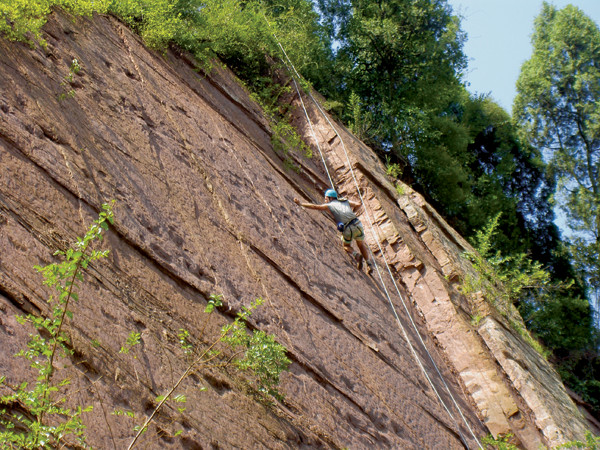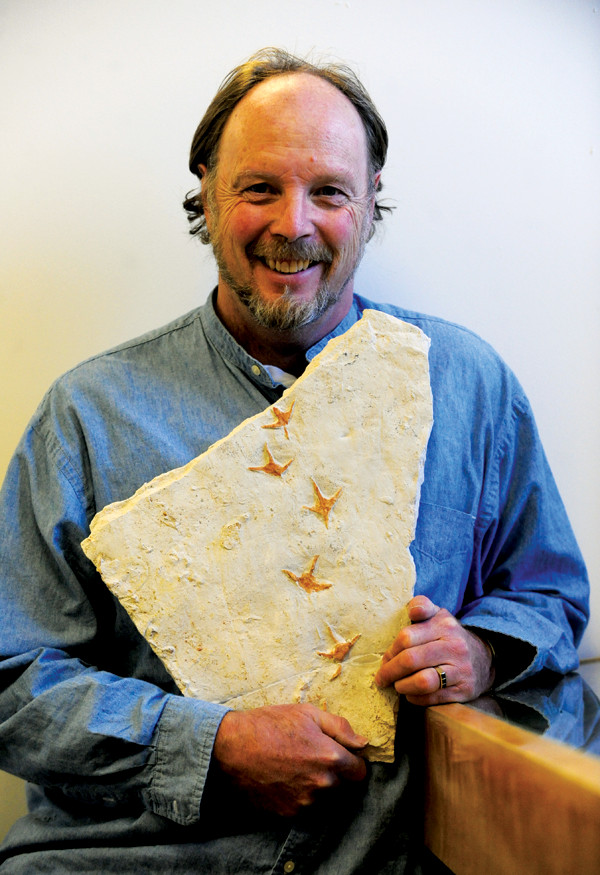
by Terri Cook Monday, June 16, 2014

Lockley scaling an outcrop to examine some tracks. Credit: Martin Lockley.
Shortly after a young Martin Lockley — a British paleontologist specializing in marine fossils — arrived in Denver in 1980 to begin a new job as a geology professor at the University of Colorado (CU), a student asked if he would like to check out some interesting dinosaur tracks. The tracks were located near the town of Gunnison, Colo., about four hours southwest, on the ceiling of an underground coal mine. Lockley and the student drove down to the site, and, agreeing that the impressions in the rock were tracks but not knowing much about them, Lockley carefully documented the site. At the time, little scientific literature existed on ancient tracks, so after publishing the information, Lockley — much to his own surprise — immediately became known as a dinosaur track expert.
Today, Lockley is considered one of the world’s foremost authorities on fossil footprints. While working for the last 34 years as a professor and director of the Dinosaur Tracks Museum at CU-Denver, he has traveled the world researching hundreds of track sites, including those made by pterosaurs, birds, mammals and more recently, early humans. He has documented the finds in more than 600 scientific articles and nearly a dozen books. Lockley recently spoke with EARTH contributor Terri Cook about what launched his illustrious career, how his father won an Oscar, and the many projects he is hoping to complete now that he is officially retired.
TC: When did you decide to focus your career on fossils?
ML: I grew up on and around a series of nature reserves in Wales, so from an early age I was steeped in natural history. As a schoolboy, I was also really into sports, so I have spent most of my life outdoors. I didn’t really know what I wanted to do when I graduated from [secondary] school because I was caught up in competitive athletics; I wasn’t even sure I would go to university. I’d seen my father be successful without attending, so I traveled for a couple of years. When I returned to the U.K., I went to the Queens University Belfast. In British universities, you have to take three subjects in your first couple of years, so I studied geography, geology and archaeology. The head of the geology department was very charismatic and captured my attention, so I stuck with geology. The year I graduated, my mentor moved to the University of Birmingham. I still wasn’t sure what I really wanted to do, so I decided to keep studying fossils. I began casting around for a graduate school, and my mentor invited me to come work with him. This was a pivotal moment in my life.

Paleontologist Martin Lockley. Credit: Martin Lockley.
TC: How did you become interested in writing?
ML: My father, who was an ornithologist, was also a writer who left quite a literary legacy. He published 58 books in his lifetime and used to say that writing is a disease. I would go so far as to say that writing some things gets in the way of writing other things. In recent years, I’ve published a lot of scientific articles and put books on the back burner. However, I don’t want to do that for too long. I love to write, and I have a whole backlog.
TC: How many writing projects are you currently juggling?
ML: My bread and butter are fossil footprints. I wrote “Dinosaur Tracks of Western North America” [1995] and “Dinosaur Tracks and Other Fossil Footprints of Europe” [2000]. A long time ago, I also began “Fossil Footprints of Asia,” but it’s gotten out of control because there’s so much material. I’m hoping to finish that before too long.
About 10 years ago, I started another book tentatively called “The Tracker Priests.” It’s about seven priests who studied fossil footprints and who, collectively, span the history of modern geology. It begins with William Buckland, the first professor of geology at Oxford in 1820, and ends with an Italian priest who is still alive and almost singlehandedly did most of the work on the fossil footprints of South America. The middle is about Pierre Teilhard de Chardin, who wrote in a visionary way about evolution and described the first fossil footprints found in China.
I’m also assembling an anthology of my dad’s work based upon the diaries he handwrote for 65 years. My father was good friends with Julian Huxley [and] together they made a film in 1934 called “The Private Life of the Gannets.” It has been described as the first authentic wildlife documentary, and it won an Oscar [in 1938]. I’ve started writing a short book about it.
TC: What was your motivation for creating the Dinosaur Tracks Museum?
ML: That will be one of the chapters in my own biography. During my first sabbatical [in the late 1980s], I started collecting tracks for the Museum of Western Colorado and gained experience designing international museum exhibits, one of which was seen by more than a million people in Japan. Later, I approached the [University of Colorado] administration about starting our own museum, and they gave me a little seed money to create the Dinosaur Tracks Museum on the Denver campus. Today, the collection includes about 3,000 fossil footprints — half of which are original (the rest are rubber molds and replicas) — from 24 countries and spanning nearly 350 million years. The entire photo-catalog will soon be online, so you’ll be able to look at an image of any track in the collection.
TC: Can you obtain different information from a track versus a skeleton?
ML: With tracks, you’re almost always talking generally: Ornithopod dinosaurs, for example, rather than a particular species represented by the bones. When I first got into this, people said that dinosaur tracks were rare, which was a myth. We’ve actually shown that they are much more common than bones. People also said that tracks are only useful when you don’t have bones. This is also not true. If you have a formation where the bones and tracks are all sauropods, for example, then they tell the same story. But if the tracks and bones tell different stories, that is very significant.
TC: Why did you recently start studying human footprints?
ML: It was serendipity. A good friend of mine in Korea found some human footprints in the most unlikely place: an offshore island that was all columnar basalt and lava caves except for one tiny volcanic ash deposit [where the tracks were located]. So he invited some people, including me, to come over and have a symposium on hominid tracks. The group decided to study hominid footprints in the literature, which, just like with dinosaur tracks, had been almost completely ignored.
Then I went to Mexico and Nicaragua. Fossil footprints [roughly 10,000 years old] were discovered in Nicaragua in the 1870s, the first reported in the Americas. People built a shelter over them but never mapped the site, so with permission I mapped the site, and also asked if I could make some molds. Then we wrote it up. The same [situation occurred] in Mexico: there were two footprints in a museum that had been collected 50 years ago. Working with other geologists, we eventually found the site, and so, along with my Mexican colleagues, I became the new expert on those tracks. There are now about 65 known human footprint sites.
TC: How did you get involved in tracking “Bigfoot” for your collection?
ML: Several anthropologists have become really interested in “Bigfoot.” I obtained casts from Jeff Meldrum, a professor of anatomy and anthropology at Idaho State University, who has written a book called “Sasquatch: Legend Meets Science.” He has more than 200 plaster casts of “Sasquatch” footprints, half of which he inherited from a former anthropology professor at the University of Washington, who also wrote a book on the legend.
In my book “The Eternal Trail: A Tracker Looks at Evolution,” I noted that there are quite a lot of animals and birds that were thought not to exist but whose footprints were found, and later the [live] animals were found. One of the most famous is the Takahē bird. It was first discovered as a fossil on the North Island of New Zealand. In the 1850s, a bunch of sailors on the South Island awoke one day to find huge footprints in the snow. They followed the prints and caught this bird. When it died, they kept the skin and skull and delivered it to London. People tried to find more, but no one did, so in the zoological literature scientists wrote that it was extinct. Then, more than 100 years later, a guy was up on what the Māori called Takahē Ridge and he caught one, which led to the discovery of a living population of about 150 Takahē. I like to keep an open mind, and I don’t like it when people say something is impossible. There are a lot of things we used to think were impossible, like the moon influencing the tides on Earth.
TC: Is there a discovery that stands out in your mind?
ML: I once had an experience while driving from Moab, Utah, to Grand Junction, Colo. I saw a slab of rock on the other side of the Colorado River, and thought, “that has to have tracks on it.” So I detoured to the slab, and it had some beautiful tracks. I looked around the hillside all the next day but didn’t find anything else. How did I tune into that?
The other discovery that stands out was in 2005. I was walking along a beach in Korea and saw a slab about half the size of a table with two beautiful Minisauripus [dinosaur] tracks, which are tiny — less than 2.5 centimeters long. It was only the second-known occurrence of these tracks. Later, we found another site with raindrop impressions that were bigger than the Minisauripus tracks beside it.
TC: What other projects will you be tackling in your retirement?
ML: I haven’t let go of my involvement in tracks museums. I’m working as the science director of a huge dinosaur museum being developed near Moab called Moab Giants. There will be a theater where visitors get an introduction to the history of life, from the Big Bang to the Permian extinction, and when you walk out the door, you’ll find yourself in the Triassic. There you will see full-size dinosaur models from that period and follow a trail through a menagerie of more Jurassic and Cretaceous dinosaurs, before returning to the central facility to see the indoor tracks museum. When visitors reach the Holocene, we will talk about how humans are now creating new types of trace fossils, like writing and painting, not just footprints or cut-marks on bones. Petroglyphs are a continuation of trace fossils, as is everything in our written record; tracking never ends.
© 2008-2021. All rights reserved. Any copying, redistribution or retransmission of any of the contents of this service without the expressed written permission of the American Geosciences Institute is expressly prohibited. Click here for all copyright requests.